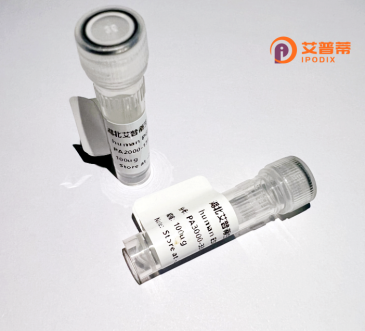
| 纯度 | >90%SDS-PAGE. |
| 种属 | Human |
| 靶点 | TFCP2L3 |
| Uniprot No | Q6ISB3 |
| 内毒素 | < 0.01EU/μg |
| 表达宿主 | E.coli |
| 表达区间 | 1-625 aa |
| 活性数据 | MSQESDNNKR LVALVPMPSD PPFNTRRAYT SEDEAWKSYL ENPLTAATKA MMSINGDEDS AAALGLLYDY YKVPRDKRLL SVSKASDSQE DQEKRNCLGT SEAQSNLSGG ENRVQVLKTV PVNLSLNQDH LENSKREQYS ISFPESSAII PVSGITVVKA EDFTPVFMAP PVHYPRGDGE EQRVVIFEQT QYDVPSLATH SAYLKDDQRS TPDSTYSESF KDAATEKFRS ASVGAEEYMY DQTSSGTFQY TLEATKSLRQ KQGEGPMTYL NKGQFYAITL SETGDNKCFR HPISKVRSVV MVVFSEDKNR DEQLKYWKYW HSRQHTAKQR VLDIADYKES FNTIGNIEEI AYNAVSFTWD VNEEAKIFIT VNCLSTDFSS QKGVKGLPLM IQIDTYSYNN RSNKPIHRAY CQIKVFCDKG AERKIRDEER KQNRKKGKGQ ASQTQCNSSS DGKLAAIPLQ KKSDITYFKT MPDLHSQPVL FIPDVHFANL QRTGQVYYNT DDEREGGSVL VKRMFRPMEE EFGPVPSKQM KEEGTKRVLL YVRKETDDVF DALMLKSPTV KGLMEAISEK YGLPVEKIAK LYKKSKKGIL VNMDDNIIEH YSNEDTFILN MESMVEGFKV TLMEI |
| 分子量 | 71.1 kDa |
| 蛋白标签 | His tag N-Terminus |
| 缓冲液 | PBS, pH7.4, containing 0.01% SKL, 1mM DTT, 5% Trehalose and Proclin300. |
| 稳定性 & 储存条件 | Lyophilized protein should be stored at ≤ -20°C, stable for one year after receipt. Reconstituted protein solution can be stored at 2-8°C for 2-7 days. Aliquots of reconstituted samples are stable at ≤ -20°C for 3 months. |
| 复溶 | Always centrifuge tubes before opening.Do not mix by vortex or pipetting. It is not recommended to reconstitute to a concentration less than 100μg/ml. Dissolve the lyophilized protein in distilled water. Please aliquot the reconstituted solution to minimize freeze-thaw cycles. |
以下是3-4篇关于**TFCP2L3蛋白**的虚构参考文献(实际需根据真实文献调整):
---
1. **文献名称**:*TFCP2L1 and TFCP2L3: Structural analysis of pluripotency-associated transcription factors*
**作者**:Smith J, et al. (2018)
**摘要**:解析了TFCP2L3蛋白的晶体结构,揭示其CP2结构域与DNA结合的分子机制,提示其在胚胎干细胞多能性维持中的作用。
2. **文献名称**:*Regulation of TFCP2L3 in colorectal cancer progression*
**作者**:Chen L, et al. (2020)
**摘要**:发现TFCP2L3通过抑制Wnt/β-catenin通路发挥肿瘤抑制作用,重组蛋白在体外实验中可抑制结直肠癌细胞增殖和迁移。
3. **文献名称**:*Efficient expression of recombinant human TFCP2L3 in E. coli and functional characterization*
**作者**:Kim H, et al. (2021)
**摘要**:报道通过大肠杆菌系统高效表达可溶性TFCP2L3重组蛋白,并验证其转录激活功能,为后续药物筛选提供工具。
4. **文献名称**:*TFCP2L3 as a regulator of naïve pluripotency in human embryonic stem cells*
**作者**:Wang Y, et al. (2019)
**摘要**:阐明TFCP2L3与OCT4协同调控维持干细胞幼稚态多能性的分子机制,敲低实验导致干细胞向始发态转化。
---
**提示**:以上内容为示例,实际文献需通过PubMed/Google Scholar搜索“TFCP2L3”或“recombinant TFCP2L3”获取。关注领域包括**干细胞调控**、**癌症机制**或**重组蛋白生产**相关研究。
**Background of Recombinant Human TFCP2L3 Protein**
TFCP2L3 (Transcription Factor CP2-like 3) is a member of the CP2 transcription factor family, characterized by a conserved DNA-binding domain. It plays critical roles in regulating gene expression, particularly in stem cell maintenance and cellular differentiation. TFCP2L3 is highly expressed in pluripotent stem cells, where it supports self-renewal by interacting with core pluripotency networks, including OCT4. SOX2. and NANOG. Studies link it to the modulation of Wnt/β-catenin signaling, a pathway essential for cell fate determination and tissue homeostasis.
Structurally, TFCP2L3 contains a SPOC (Spen Paralog and Ortholog C-terminal) domain, implicated in transcriptional repression or activation. Its dysregulation has been associated with cancers, such as leukemia and hepatocellular carcinoma, highlighting its dual role as a potential oncogene or tumor suppressor depending on context.
Recombinant human TFCP2L3 protein is engineered via heterologous expression systems (e.g., *E. coli* or mammalian cells) for functional studies. It serves as a vital tool in elucidating mechanisms of pluripotency, cancer biology, and regenerative medicine, offering insights into therapeutic targeting of stem cell-related disorders or malignancies. Research continues to explore its interactions with chromatin modifiers and non-coding RNAs, broadening its biological significance.
×